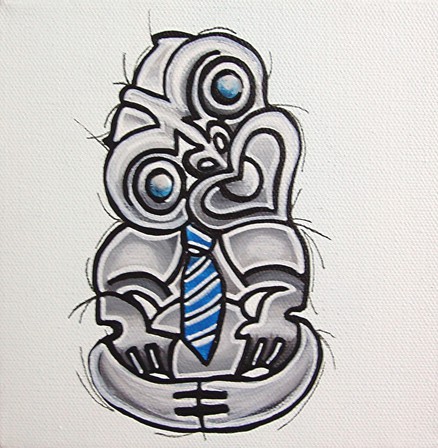Te Tiki: New Zealand Art
"Te tiki" is a contemporary New Zealand art piece that Collette created for an exhibition at Southwell School in Hamilton, which held annual art expos in which Collette took part for many years.
In 2010 they asked artists to paint something that represents the school on a 150mm x 150mm canvas as an extra for the exhibition. These artworks were tiny but impactful and a great fundraiser for the school.
Collette chose the symbolic Tiki and painted it using the Southwell School colours with the school 'tie' tieing it in.
Acrylic on canvas with resin eyes. "Te tiki" is a New Zealand contemporary art piece by Collette Fergus, an artist based in Hamilton NZ
What is Tiki in New Zealand Maori Culture?
In New Zealand's indigenous Māori culture, few symbols are as iconic and instantly recognisable as the Tiki. Steeped in history, spirituality, and artistry, Tiki holds a special place in the hearts and minds of the Māori people with rich symbolism, cultural significance, and evolution of Tiki within Māori society.
The Origin and Symbolism of Tiki
The term "Tiki" refers to humanoid figures carved from stone, wood, or other materials, typically depicting a human form with large eyes, a prominent nose, and a distinctly stylised facial expression. The exact origin of the Tiki is shrouded in the mists of time, dating back centuries to the early Polynesian settlers who first arrived in Aotearoa, New Zealand.
Tiki figures permeate with rich symbolism, representing various aspects of Māori spirituality, ancestral connections, and cultural identity. In Māori mythology, Tiki is often considered the first human being, the progenitor of all humans. They are believed to possess a spiritual essence that can bring protection, fertility, and good fortune.
Tiki's significance closely ties to the concept of mana, a spiritual energy or power that flows through all things. It is believed that Tiki figurines, when adorned with pounamu (greenstone) or other sacred materials, can amplify and channel this mana, connecting the spiritual and physical realms.
Evolution of Tiki
While the core symbolism of Tiki has remained relatively consistent over time, its representation and artistic styles have evolved. Historically, Tiki figures were predominantly carved from wood and stone, serving as practical objects and spiritual talismans.
These carvings were often worn as pendants, known as hei-tiki, and passed down through generations as treasured heirlooms.
In contemporary times, Tiki art has evolved even further, embracing a range of mediums such as paintings, prints, tattoos, and sculptures, reflecting the dynamic nature of Māori culture.
Cultural Significance of Tiki Today
Tiki remains an enduring symbol of Māori identity and pride, not only in New Zealand but also around the world. It serves as a visual representation of Māori culture and heritage, carrying profound meaning for Māori individuals and communities. Tiki carvings are often prominently displayed in marae (traditional meeting houses), museums, galleries, and cultural events.
Moreover, Tiki has become a recognised symbol of New Zealand, often associated with tourism and souvenirs. However, it is crucial to approach the commodification of Tiki with cultural sensitivity, as its significance extends far beyond mere trinkets. Respecting the cultural context and understanding the depth of meaning behind Tiki is vital to appreciate its actual value.
At the End of the Day
The Tiki stands as an unforgettable symbol of Māori culture, embodying the spiritual essence, ancestral connections, and artistic craftsmanship of the Māori people. Its enduring presence in various forms of art and adornment underscores its importance as a cultural touchstone.
